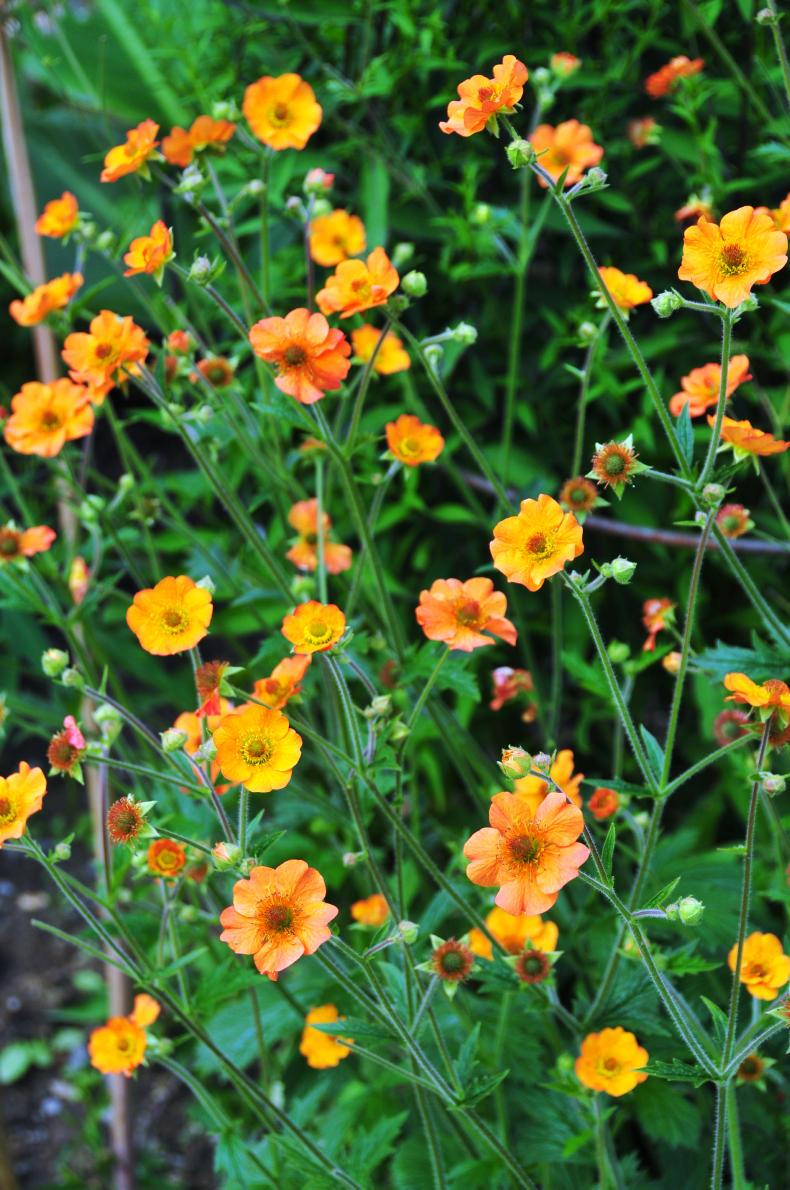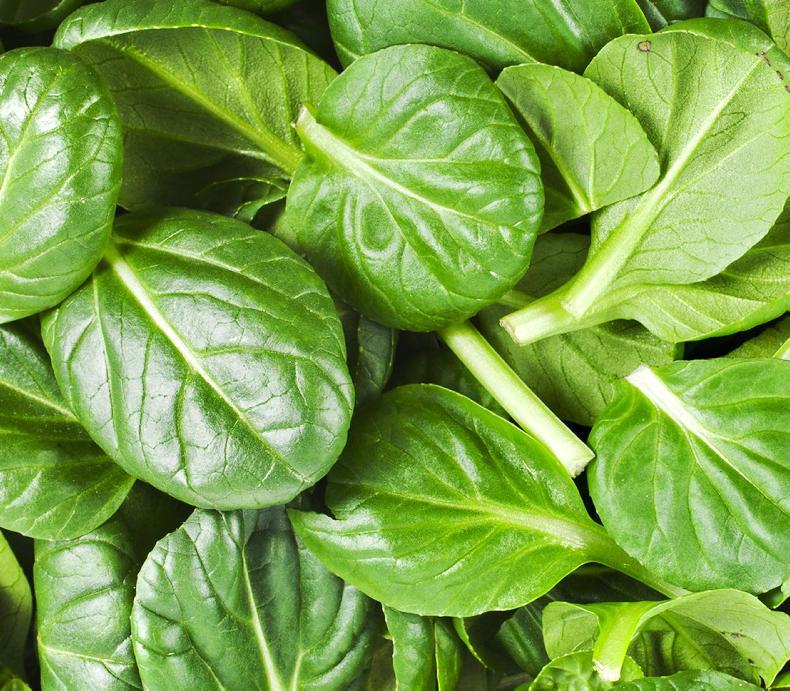Geum makes a rosette of leaves at soil level and throws up tall, branching sprays with yellow, orange or red flowers. It is good for a sunny border and has become more popular again in recent years, having been largely forgotten and relatively neglected.
Its bright, brassy colour lost favour when the fashion was for pastel tones and white flowers. However, hot colour is back in vogue and these plants are ideal for use in a red or purple colour-themed border.
They are very natural flowers in appearance and also good value; starting to flower early and bringing colour to the border in early summer before the main show of herbaceous flowers that comes later.
It can produce some late flowers if the plants are growing in good soil that does not dry out too much and encourages fresh growth. They need to be lifted and divided every few years to maintain their vigour.

Geum 'totally tangerine'
Geum fits the role of a filler very well, providing good background and a fine foil for larger, more impressive flowers. These plants go well with bronze foliage and red, yellow and red-purple flowers.
The plants hold their flowers quite high on slender, branching stems, an open structure. The flowers of geum are like small roses in shape and geum is part of the rose family.
Geum is also called avens and there are two native species here, wood avens and water avens, the latter having drooping flowers. The leaves have leaflets matching and a large leaflet segment at the top of the leaf.
The water avens is grown in gardens as a hybrid called Leonard’s variety, a very beautiful form with upright stems and coppery-pink flowers, slightly nodding, flowering from mid-summer. Coppertone has brown flower stems and copper-apricot flowers with wavy petals.
Lemon Drops is yellow, drooping at first, with brownish sepals behind the petals.
These varieties are relatively new and are hybrids with the native water avens, Geum rivale. They like fertile soil that is on the moist side, but not boggy or waterlogged. But the more traditional border perennials are derived from the Chilean species Geum chiloense.
The most widely grown kind is Mrs J Bradshaw, with semi-double scarlet flowers from early summer and some later in summer. Lady Stratheden has semi-double, bright yellow flowers and is widely grown.
They are easy to grow in good, ordinary, well-drained soil in sunshine
Prince of Orange has large, bright orange flowers. Princess Juliana has bright yellow, semi-double flowers with a tinge of red. Dolly North has bright, deep orange flowers.
These are all about 60cm tall, a bit more or a bit less. They are easy to grow in good, ordinary, well-drained soil in sunshine.
They can be grown from seeds quite easily, even sown outdoors in a fine seed bed, ideal saving for those on a budget, starting a new garden or refurbishing an old one.
Spinach has not normally been a traditional crop, but as tastes in food widen more people are eating it. While leaf beet is often eaten as a spinach substitute, the true spinach has much better flavour – though it is not as easy to grow.

Spinach leaves.
Spinach has a tendency to bolt if conditions vary. It can be sown from spring to autumn, the latter sowing to overwinter.
Early and late sowings are most prone to bolting and a sowing in early to mid-summer is usually the most successful. The best way to succeed is to sow a few seeds every three weeks or so. Some will fail, but other sowings will work. Sow in a warm, sunny spot with good, rich, moisture-retentive soil. Part-day shade can help on soils that get too hot or dry in the summer and watering is more or less essential.
Fruit, vegetables and herbs
Sow the salad vegetables that mature quickly. Peas could still be sown, but are unlikely to give much unless weather conditions suit them. Plant outwintering cabbage varieties, if not already done. Listen out for potato blight warnings if the variety is susceptible.
Trees, shrubs and roses
Prune late-flowering spring and early shrubs such as weigela and viburnum, that have finished if they are spreading too much. Rainfall may not be enough to reach the roots and they should be checked for water needs. Prune early shrub roses and ramblers gone over.
Lawn
Grass growth was mixed in spring this year. It depends on how the weather goes, but if it stays dry the moisture reserves deep in the soil might not be replenished and lawns will struggle in the coming weeks. Do not feed unless heavy rain is due, as fertiliser can cause damage.
Flowers
Seeds of perennial flowers such as lupins, mallows and foxgloves could be sown now for flowering next year. Bedding plants in pots and baskets need regular watering and feeding. Because the roots have now filled the pots, watering and feeding has become more critical.
Greenhouse and house plants
Continue watering and feeding all greenhouse and house plants. Water plants in pots or grow-bags regularly, because these can easily dry out and cause blossom-end rot on tomatoes and peppers. Train tomatoes and cucumbers up strings or canes and remove side-growths.
Geum makes a rosette of leaves at soil level and throws up tall, branching sprays with yellow, orange or red flowers. It is good for a sunny border and has become more popular again in recent years, having been largely forgotten and relatively neglected.
Its bright, brassy colour lost favour when the fashion was for pastel tones and white flowers. However, hot colour is back in vogue and these plants are ideal for use in a red or purple colour-themed border.
They are very natural flowers in appearance and also good value; starting to flower early and bringing colour to the border in early summer before the main show of herbaceous flowers that comes later.
It can produce some late flowers if the plants are growing in good soil that does not dry out too much and encourages fresh growth. They need to be lifted and divided every few years to maintain their vigour.

Geum 'totally tangerine'
Geum fits the role of a filler very well, providing good background and a fine foil for larger, more impressive flowers. These plants go well with bronze foliage and red, yellow and red-purple flowers.
The plants hold their flowers quite high on slender, branching stems, an open structure. The flowers of geum are like small roses in shape and geum is part of the rose family.
Geum is also called avens and there are two native species here, wood avens and water avens, the latter having drooping flowers. The leaves have leaflets matching and a large leaflet segment at the top of the leaf.
The water avens is grown in gardens as a hybrid called Leonard’s variety, a very beautiful form with upright stems and coppery-pink flowers, slightly nodding, flowering from mid-summer. Coppertone has brown flower stems and copper-apricot flowers with wavy petals.
Lemon Drops is yellow, drooping at first, with brownish sepals behind the petals.
These varieties are relatively new and are hybrids with the native water avens, Geum rivale. They like fertile soil that is on the moist side, but not boggy or waterlogged. But the more traditional border perennials are derived from the Chilean species Geum chiloense.
The most widely grown kind is Mrs J Bradshaw, with semi-double scarlet flowers from early summer and some later in summer. Lady Stratheden has semi-double, bright yellow flowers and is widely grown.
They are easy to grow in good, ordinary, well-drained soil in sunshine
Prince of Orange has large, bright orange flowers. Princess Juliana has bright yellow, semi-double flowers with a tinge of red. Dolly North has bright, deep orange flowers.
These are all about 60cm tall, a bit more or a bit less. They are easy to grow in good, ordinary, well-drained soil in sunshine.
They can be grown from seeds quite easily, even sown outdoors in a fine seed bed, ideal saving for those on a budget, starting a new garden or refurbishing an old one.
Spinach has not normally been a traditional crop, but as tastes in food widen more people are eating it. While leaf beet is often eaten as a spinach substitute, the true spinach has much better flavour – though it is not as easy to grow.

Spinach leaves.
Spinach has a tendency to bolt if conditions vary. It can be sown from spring to autumn, the latter sowing to overwinter.
Early and late sowings are most prone to bolting and a sowing in early to mid-summer is usually the most successful. The best way to succeed is to sow a few seeds every three weeks or so. Some will fail, but other sowings will work. Sow in a warm, sunny spot with good, rich, moisture-retentive soil. Part-day shade can help on soils that get too hot or dry in the summer and watering is more or less essential.
Fruit, vegetables and herbs
Sow the salad vegetables that mature quickly. Peas could still be sown, but are unlikely to give much unless weather conditions suit them. Plant outwintering cabbage varieties, if not already done. Listen out for potato blight warnings if the variety is susceptible.
Trees, shrubs and roses
Prune late-flowering spring and early shrubs such as weigela and viburnum, that have finished if they are spreading too much. Rainfall may not be enough to reach the roots and they should be checked for water needs. Prune early shrub roses and ramblers gone over.
Lawn
Grass growth was mixed in spring this year. It depends on how the weather goes, but if it stays dry the moisture reserves deep in the soil might not be replenished and lawns will struggle in the coming weeks. Do not feed unless heavy rain is due, as fertiliser can cause damage.
Flowers
Seeds of perennial flowers such as lupins, mallows and foxgloves could be sown now for flowering next year. Bedding plants in pots and baskets need regular watering and feeding. Because the roots have now filled the pots, watering and feeding has become more critical.
Greenhouse and house plants
Continue watering and feeding all greenhouse and house plants. Water plants in pots or grow-bags regularly, because these can easily dry out and cause blossom-end rot on tomatoes and peppers. Train tomatoes and cucumbers up strings or canes and remove side-growths.








 This is a subscriber-only article
This is a subscriber-only article









SHARING OPTIONS: